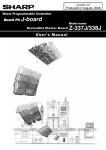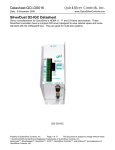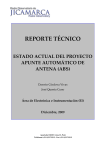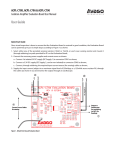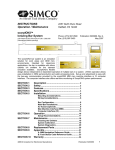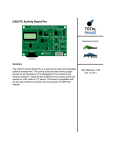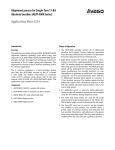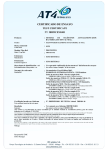Download User`s Manual - Avago Technologies
Transcript
ACPL-337J Isolated IGBT Gate Driver Evaluation board User's Manual Quick-Start Visual inspection is needed to ensure that the evaluation board is received in good condition. Default connections of the evaluation board are as shown (see Figure 1): 1. Q1 (Bipolar Buffer Driver), Q2 (Miller Clamp Bipolar) and Q3 (IGBT) are not mounted. An actual IGBT should be mounted at Q3 (for TO-247 package), or connected to the driver board through short wire connections from the holes provided at Q3. 2. CON3 is provided to allow for positive supply (VCC2) and negative supply (VEE2) with respect to VE (marked as E, which is connected to emitter pin of the IGBT). 3. J1 jumper is shorted by default to connect the output to the Gate pin of the IGBT, through gate resistors R6 (10 Ω) & R7 (0 Ω); 4. R9, R10 and Q1 (provisions for buffer driver) are not mounted by default. These components will be needed if more than 4 A of gate drive current is required (J1 must be removed while R7 must then be shorted to accommodate this). 5. Similarly, Q2 is not mounted by default. This component should be mounted, however, if Miller Clamp current of more than 2 A is required; 6. CON2 and J2 are shorted by default to allow for a single input PWM signal at Vin+ (pin 2 of CON1) to drive the LED of ACPL-337J. If a separate LED drive signal (across R3 and R4) is required, then CON2 (and J2 if R4 cannot be grounded to Gnd) must be opened. 7. CON1 is provided to allow for the power supply (+5V) to be connected across VCC1 and Gnd, TTL signal drive at Vin+, direct driving of LED, plus /UVLO and /Fault feedback. Component Side Solder Side Gnd Vin+ Vcc1 /UVLO /Fault LED+ LED− J2 shorted CON2 shorted J1 shorted Figure 1. Actual ACPL-337J evaluation board showing default connections Once inspection is done, the evaluation board can be powered up in seven simple steps, as shown in Figure 2, in simulation mode, without the need of actual IGBT. Testing IGBT Gate Driver (in Simulation Mode) 1. Solder a 10 nF capacitor across the Gate and Emitter terminals of Q3 (to simulate actual gate capacitance of an IGBT). 2. Solder a jumper wire across the Collector and Emitter terminals of Q3 (to simulate a turn-on saturated Collector voltage of IGBT). 3. Connect a +5V DC supply (DC supply 1) across VCC1 and GND terminals of CON1. 4. Connect another DC supply (DC Supply 2 of +15 V typical or +30 V maximum) across VCC2 (VCC2 pin) and VE (E pin) terminals of CON3. Connect a third DC supply (DC Supply 3 of -5V typical or -15 V maximum) across VEE2 (VEE2 pin) and VE (E pin) terminals of CON3. Maximum voltage across VCC2 and VEE2 is 30 V. For testing, these power supplies can be non-isolated. 5. Connect a 10 kHz 5 V DC pulse (at about 50% duty) from a dual-output signal generator across IN+ and Gnd pins of CON1 to simulate microcontroller output to drive the IGBT. 6. Use a multichannel digital oscilloscope to capture the waveforms at the following points: a. Input PWM signal at IN+ pin (CON1) with reference to (w.r.t.) Gnd. b. LED signal at LED+ pin w.r.t. Gnd (or LED-). Note: this is a generated LED drive signal from the device ACPL-337J. c.VG representing the gate drive voltage of ACPL-337J (U1) at G (gate) pin of Q3 w.r.t. E (emitter) pin. d. Desat signal at pin 14 of U1, which represents the Desat voltage of IGBT’s C (collector) pin during turn-on. e. Confirm that LED+ signal is almost identical to IN+ signal, and then switch this channel to monitor the simulated Miller Clamp voltage of IGBT at pin 10 of U1. 7. Provision is done on the board to allow for the LED to be driven directly by 5 V PWM (10 kHz) signals instead of the IN+ signal by disconnecting the shunt post at CON2. Once the shunt post at CON2 is removed, the external PWM signals (at 10 kHz 5VPP) can be connected directly to LED+ and LED- pins at CON1. Note: Before you proceed to the next tests, make sure you remove the jumper wire that was connected in Step 2. –5V 4 DC Supply 1 Gnd 3 Vin+ 6a Vcc1 /UVLO /Fault 6b LED+ LED- Figure 2. Simple Simulation Test Setup of Evaluation board 2 0V +15V 5 DC Supply 3 Gnd in+ +5V Signal Input DC Supply 2 6d 6e 6c 1 10 nF 2 Jumper Short Schematics Figure 3 shows the schematics of the evaluation board. CON1 1 µF C3 + T A R2 R1 10k 1 VEE1 VEE2 16 2 VIN+ VLED 15 3 VCC1 DESAT 14 4 VLEDDRV 10k 5 UVLO CON2 6 FAULT VOUT 11 150 7 ANODE VCLAMP 10 150 8 CATHODE C2 330pF R3 R4 J2 VCC2 12 VEE2 1 µF C7 + T A C R5 1k D1 VCC2 VE 1 kV 7,8 1 R6 2W 10 VEE2 9 C5 + 1 µF TA R9 J1 R10 Q1b R7 2W 0R Q3 C (TO247) G 3 nm R8 47 3 PBSS4041SPN 5,6 1 Q2 nm4,2 2STN2540 nm :Not Mounted Figure 3. Schematics of the ACPL-337J evaluation board nm BYV26E Q1a nmPBSS4041SPN 2 Gnd 3 E VE C6 100pF 1 µF C4 + T A G nm C1 330pF VCC2 SBD BAT42W VE 13 CON4 CON3 nm Gnd 4 V EE2 nm E VE Practical Connections of the Evaluation board Using Power MOSFET for Actual Inverter Test 1. Solder an actual IGBT at Q3 by following the pins marked as G (gate), C (collector) and E (emitter). 2. Connect a +5V DC supply (DC supply 1) across VCC1 and GND terminals of CON1. 3. Connect another DC supply (DC Supply 2 of +15V) across VCC2 (VCC2 pin) and VE (E pin) terminals of CON3. Connect a third DC supply (DC Supply 3 of -5V typical or -15V max) across VEE2 (VEE2 pin) and VE (E pin) terminals of CON3. Maximum voltage across VCC2 and VEE2 is 30 V. These two DC power supplies must be isolated from DC Supply 1. 4. Connect the PWM output signals(meant to drive the IGBT) from microcontroller to input signals at IN+ and Gnd pins of CON1; Connect also the /UVLO and /Fault from CON1 to the same microcontroller at designated feedback pins. 4 Microcontroller IN+ –5 V 0V DC Supply 3 3 Gnd DC Supply 2 2 6 HV+ IGBT Gnd Vin+ 5a Vcc1 /UVLO /Fault 5c 1 Inductive Load Gnd DC Supply 1 +5V +15 V 5. Use a multi-channel Digital Oscilloscope to capture the waveforms at the following points: a. Input PWM signal at IN+ pin (CON1) with reference to (w.r.t.) Gnd b.VG representing the gate drive voltage of ACPL-337J (U1) at G (gate) pin of Q3 w.r.t. E (emitter) pin. Monitoring of this signal must be done through a HV differential probe c. Desat signal at pin 14 of U1 represents the Desat voltage of IGBT’s C (collector) pin during turn-on. Monitoring of this signal must be done through a HV differential probe d. Miller Clamp voltage of IGBT at pin 10 of U1. Monitoring of this signal must be done through a HV differential probe 6. Connect C (collector) pin of the IGBT to HV+ (High Voltage DC Bus+) through a properly selected Inductive Load. Connect E (emitter) pin of the IGBT to HV- (High Voltage DC Bus-). (Note: It is advised to enable the current limiting function of the HV Power Source supplying the High Voltage DC Bus voltage during this test to protect the Inverter and its drive circuits). Maximum voltage allowed across HV+ and HV- is 1 kV for the board. 5b 5d O/P LED+ LED HV– Figure 4. Connection of evaluation board in actual applications 4 Application Circuit Description The ACPL-337J is an isolated gate driver that provides >4 A output current. The voltage and high peak output current supplied by this optocoupler make it ideally suited for direct driving of IGBT with ratings up to 1000 V/100 W. It is also designed to drive different sizes of buffer stage that will make the class of IGBT scalable. ACPL-337J provides a single isolation solution suitable for both low power and high power ratings of motor control and inverter applications. Each of the ACPL-337J evaluation boards, as shown in Figure 5, accommodates an ACPL-337J IC. The board is enough to drive an Inverter arm. This allows the designer to easily test the performance of gate driver in an actual application solution. Operation of the evaluation board requires just the inclusion of a common 5V DC isolated Supply1 on the input side and two isolated DC supplies on the output side, together with a PWM drive signal from the microcontroller. Provision is done on the board to allow for the LED to be driven either directly by external 5V PWM (10 kHz) signals or the generated LED signal, by disconnecting or connecting the shunt post at CON2, respectively. By default, the LED is driven by the internally generated LED drive signal (LEDDRV pin 4 at U1). Once the shunt post at CON2 is removed, external PWM signals (at 5VPP 10 kHz) can be connected directly to LED+ and LED- pins at CON1 to drive the LED of the optocoupler through the onboard current limiting resistors. This provision is to provide the designer flexibility. Once the LED is driven by a signal current (typically 11.5 mA), output at pin 11 is activated with a positive pulse voltage and ready to drive the IGBT’s gate through a gate resistor R6 (10 Ω). Assuming that the voltage supply at VCC2 and VEE w.r.t. VE (or E) are +15V and -5V respectively, the maximum drive current is limited to 2 A peak (= (VCC2 – VEE)/RG). If needed, RG can be reduced to accommodate up to 4 A of peak output drive current allowable by the specification. But care must be taken to ensure that junction temperature of the device is always below 125 °C. ACPL-337J is a smart gate driver with many integrated protection features such as: a. IGBT collector desaturation fault protection against overload as well as short circuit, b. Preventing false turn-on due to Miller current effect, and c. UVLO to prevent premature output turn-on due to insufficient supply voltage. Desat Protection For normal loading during IGBT turn-on, the collector saturation voltage should fall below 5V (= Vdesat – Iconstant * Rdesat – VF), where Vdesat = 7V typical (protection threshold of Desat voltage) Iconstant = 1 mA of internal constant current source Rdesat = 1 kΩ of R5 VF = 1V (typical) of D1 for BYV26E at 1 mA During overload or short circuit, the collector saturation voltage is higher than 5 V and the detected voltage at the Desat pin 14 of U1 will be higher than 7 V. This will trigger output shutdown (output soft shutdown will be initiated and at the same time the /Fault feedback pin 6 will be pulled low to inform external microcontroller that there is a Fault happening at the IGBT power switch) to turn off the IGBT to protect it from damage. So the IGBT should be selected such that its collector saturation voltage during turn-on under full load condition is less than 5 V. If the collector saturation voltage during full load is too low, e.g., < 3 V, then adding a 2 V Zener between R5 and diode D1 would definitely help to provide proper overload or short circuit protection. For other design criteria for Desat protection, refer to the application notes. Preventing false turn-on by Miller effect Every IGBT used will have a junction capacitance between collector and gate (or Miller capacitance). Ideally, this capacitance has to be as small as possible, but it can never be eliminated. This Miller capacitance might allow transient current to flow from collector to gate and causes the gate voltage to rise during gate turn-off duration. If this sudden surge of gate voltage is higher than the gate threshold voltage (usually 2~5V), a false IGBT turn-on might happen. To prevent this, the IGBT gate voltage is monitored (by connecting it to the Clamp pin 10 of U1) during the turn-off duration. During turn-off, the gate voltage, as monitored, is pulled low and it will drop from VCC2 level to VEE2 level. As soon as this gate voltage level drops below 2 V w.r.t. VEE2, an internal clamp is activated to shunt the Clamp pin 10 to pin 9, which is at VEE2 level. By doing so, it ensures that the gate voltage has no chance of getting over 2 V again during the entire IGBT off duration. Monitoring of this pin 10 will notice a sudden dip in voltage from 2 V (typically) to 0 V immediately, to confirm that the active Miller Clamp is working properly. Note: As an active Miller clamp is built-in to this ACPL-337J device, negative supply is not needed, and VE and VEE2 can be shorted. 5 Preventing premature output turn-on through the use of UVLO When IGBT is allowed to turn on immediately after gate voltage crosses the threshold voltage (typically 2~5V), the collector emitter junction is operating at the linear region. This will cause high voltage built-up across the very same junction, especially when the load is high. The conduction power dissipation (=load current * junction voltage) of the device will be very high and it will be damaged if this power is higher than the allowable limit. To prevent high power dissipation, the designer has to ensure that the turn-on of the IGBT is prohibited until the gate voltage has reached a certain level where collector saturation can be reached, and usually this calls for a gate voltage to be >12 V. This is achieved by including a UVLO circuit inside the ACPL-337J device. This UVLO circuit monitors the supply voltage at VCC2 w.r.t. VE, and it will not allow output to be turn-on until VCC2 voltage crosses the UVLO+ threshold, typically 12.3 V. The UVLO protection circuit can be checked by varying VCC2 supply voltage higher than or lower than the UVLO+ or UVLOthreshold voltage, respectively. When VCC2 supply voltage is lower than the UVLO- threshold, the /UVLO at pin 6 of U1 should send out a low level, w.r.t. Gnd. Note: As can be seen on the board, the isolation circuitry (at the far left) is easily contained within a small area while adequate spacing is maintained for good voltage isolation and easy assembly. Figure 5. Top and bottom views of ACPL-337J evaluation board 6 Using the Board The evaluation board is easily prepared for use. Only minor preparations (just by soldering cables for DC supplies, input PWM & /Fault + /UVLO feedback signals, proper cables for HV+/HV- high voltage bus, and load connections) are required. The evaluation board is having a default connection as shown in Table1 when shipped to customer. Customer is free to select a different LED driving schemes and whether negative supply is used, as shown in the Table. Table 1 VCC2 VEE2 LED is No. driven by CON2 VCC1 1 VLEDDRV s/c +5 V External +15V~30V External 0V ~ -15V External 2 VLEDDRV s/c +5 V External +15V~30V External s/c 0V 3 Microcontroller (external) open +5 V External +15V~30V External 0 V ~ -15 V External 4 Microcontroller (external) open +5 V External +15V~30V External s/c 0V 30 V maximum VE J1 J2 Remarks 0V s/c s/c Default –3 external supplies needed for VCC1, VCC2 and VEE2 s/c *1 Simplest –2 external supplies needed for VCC1 & VCC2 s/c s/c LED’s driven externally –3 external supplies needed for VCC1, VCC2a & VCC2b s/c *1 LED’s driven externally –2 external supplies needed for VCC1 & VCC2 0V Notes: *1. Whether J2 can be shorted depends on the drive signals (for connection to LED+ and LED-) from the Microcontroller. *2. Since Miller Clamp function is built-in, -ve supply for VEE2 can be omitted, so VEE2 can be shorted to VE externally. Note: As the Desat diode’s breakdown voltage is rated at 1k V, IGBT must be selected with VCES <1 kV, and maximum HV+ voltage plus flyback voltage of load inductor must be <1 kV). 7 Output Measurement A sample of Input signal and various output waveforms are captured and shown in Figure 6, during IGBT gate turn-off and turn-on instants. Default setup connection is used but with Q3 IGBT mounted. The IGBT used has a gate capacitance equivalent to 10 nF. It is noticed that during normal working condition, the Desat pin voltage is much less than 7 V, and no Fault occurs. For the exploded view, see Figure 7. Figure 6. ACPL-337J Input and output plus protection signal waveforms 2V Figure 7. Exploded view of Active Miller Clamp pin waveform at turn-off Figure 7 is the exploded view of the Miller Clamp pin-10 waveform during turn-off duration, it shows clearly that once the detected Gate voltage drops below 2 V (typically), the Gate voltage is shunt and clamped to 0 V w.r.t. VEE2 level during the entire turn-off duration, to ensure that the Gate voltage has no chance of going above the turn-on threshold level again. 8 Fault Feedback DesatFault detected Figure 8 shows the actual Desat 7 V threshold detection that triggers the VG output soft-shutdown as well as /Fault feedback pin voltage is pulled low to inform microcontroller that a fault has been detected. 7V Figure 8. Desat Protection & Fault Feedback Figure 9 shows that the VCC2 voltage sag below UVLO- level (between 11~12 V) triggers the UVLO and shutdown the output VG level and recovers after normal VCC2 voltage recovers above UVLO+ level (between 12~13 V). The /UVLO pin voltage is also pulled low throughout the same duration to inform the microcontroller that severe VCC2 level drop has happened. VCC2 VCC2 undervoltage detected /UVLO UVLO reported 15V 14V 13V 12V 11V VCC2 ’Normal’ detected VIN+ VG output 12V 13V 14V 15V Figure 9. UVLO Feedback In conclusion, with these sophisticated IGBT gate driving and driver protection schemes built-in, ACPL-337J is well suited for modern IGBT applications such as Motor Control and Voltage inverters. For product information and a complete list of distributors, please go to our web site: www.avagotech.com Avago, Avago Technologies, and the A logo are trademarks of Avago Technologies in the United States and other countries. Data subject to change. Copyright © 2005-2014 Avago Technologies. All rights reserved. AV02-4404EN - February 6, 2014










